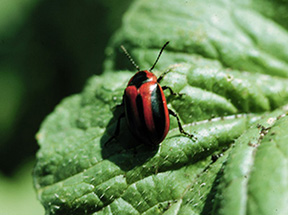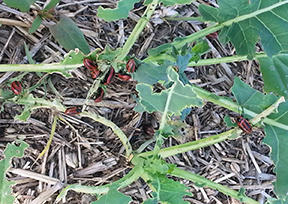E.C. Burkness and W.D. Hutchison
Department of Entomology, University of Minnesota
Introduction

Red turnip beetles, Entomoscelis americana, are typically associated with plants from the mustard family (also known as crucifers or Brassicaceae), including turnip, radish, rapeseed, mustard, and canola. They are more prevalent in areas with sandy soils. Damage caused by this beetle can range from being restricted to small portions of the plant to entire defoliation or death. The adults are easily identified by their bright red color and their distinguishing black strips.
Biology & Life Cycle
Red turnip beetle adults are 7 mm long with a bright red body. The head is covered with red and black spots, and there are three black strips that run longitudinally down its back. The red turnip beetle over winters as an egg in the soil. During early August to late October, the eggs are laid singly or in groups in cracks in the soil near the plants. After two or three weeks, the eggs are fully matured but will not hatch until the following spring. Starting in March and continuing until early May, larve hatch and begin feeding on foliage of cruciferous plants-especially volunteer canola, rapeseed, mustard, or weeds (namely fix weed and wild mustard). They primarily feed in the daytime, and if disturbed will drop to the ground.The mature larvae are 3/8 inch long with rough skin and a segmented body. The upper side of the body is usually a smoky black color while the underside is brown, and the entire body is covered with short hairs. Fully developed larvae will return to the soil to form an earthen cell and pupate. Red turnip beetle pupae are bright orange in color. They remain in the soil for approximately 14 days and emerge as adults. In late June, the adults will emerge and feed for about two or three weeks. After this feeding period, the adults will return to the soil for one month to rest only to reappear towards the end of July. Feeding damage done after this reemergence is usually not severe. Adults will continue to feed, mate, and lay eggs until late October. Each female is capable of producing 300 to 400 eggs a season and will lay them throughout the field. There is only one generation per year.
Damage

Hosts of the red turnip beetle include: canola, mustard, rapeseed, turnip, radish, and other cruciferous plants. The amount of damage that occurs depends on the level of infestation by the red turnip beetle. It can range from light foliar damage where only portions of the plant are affected, to defoliation of entire plants, which are stunted or killed. The beetle feeds on the leaves, flowers, stems, and seedpods of plants. Damage is usually obvious starting from the edges of the field and slowly spreading throughout the field.
Management
Damage usually begins in fields that have heavy infestation of weeds or volunteer plants of the mustard family that were not treated with herbicide in the fall or spring. The beetle will start with volunteer plants and slowly move into adjacent fields; therefore, it is important to prevent this from happening by controlling cruciferous weeds and volunteer plants. If possible, do not underseed canola, rapeseed, or mustard with forages. The use of herbicides is also helpful to rid fields of weeds.
Cultivation also proves to be extremely useful in the control of this pest. A beneficial time to do this is during the fall to early spring. This will disrupt or destroy the eggs and the weeds, which are the food supply for developing larvae. In addition, cultivating during mid May to mid June can reduce larval populations.
The use of insecticides may be an option if the infestation occurs in newly seeded fields in June, but it is important to examine the field for the level of damage before deciding to spray. An insecticide can be restricted to the margins of the fields since this is where initial infestations occur.To ensure proper use of insecticides, also refer to the most recent edition of the Midwest Vegetable Production Guide.
References
Canola Council of Canada. 2021. Red Turnip Beetle. https://www.canolacouncil.org/canola-encyclopedia/insects/red-turnip-beetle/
Cornell University. 2003. Vegetable Disease ID and Management http://vegetablemdonline.ppath.cornell.edu/
Manitoba Agriculture. 2020. Red turnip beetle. Government of Manitoba. Retrieved from https://www.gov.mb.ca/agriculture/crops/insects/red-turnip-beetle.html